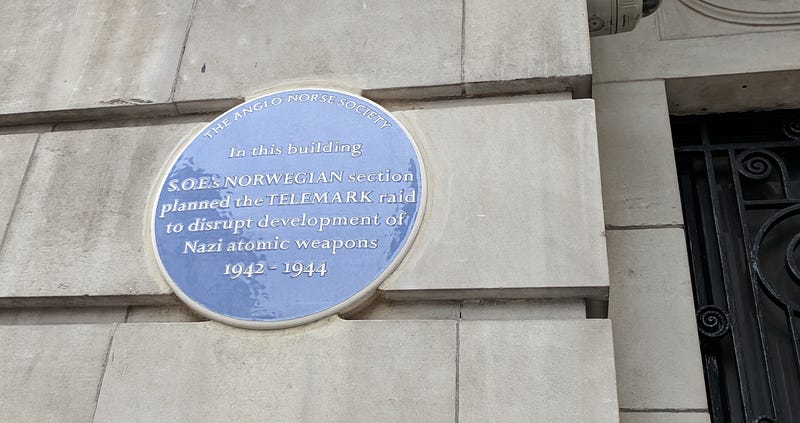Heroes of the Telemark
The Telemark operation is one of my favourite stories from the SOE, the Special Operations Executive, days. It is so incredible, and so…
The Telemark operation is one of my favourite stories from the SOE, the Special Operations Executive, days. It is so incredible, and so famous, that it was made into a film, Heroes of the Telemark, starring Kirk Douglas.
In a nondescript building, Chiltern Court, above London’s Baker Street tube station, an incredible chapter of WW2 history unfolded. These offices were the HQ for SOE’s Scandinavian operations. Such was the extent of secret SOE work in the war that they had several offices, each one focusing on a different part of Europe. There were two French sections, due to the complex Vichy politics of the day. One of them was in Dorset Square nearby. But a blue plaque notes Chiltern Court as the home of the Telemark.

Back then, virtually no country had access to nuclear technology, but its importance was certainly known. Under no circumstances must Germany be permitted access to nuclear components, thus preventing them using nuclear weapons against the Allies. There were several successful attempts to prevent access, but some were unsuccessful. Telemark contained both success and failure.
The more commonly accepted label for this work is the Norwegian Heavy Water Sabotage. Not as catchy as Telemark, which also gave its name to the flying V formation used by ski-jumpers. And skiing, this being Norway, did play a role in the work.

Since 1934, Norsk Hydro had been the first commercial factory capable of making deuterium oxide, better known as Heavy Water. It is a key ingredient for the development of nuclear material. It produced 12 tonnes a year. Before Germany invaded Norway, the government there agreed to ‘lend’ its stocks of heavy water to France until the war ended. But the plant was still capable of making new heavy water, which trouble the Allies.
Telemark was actually a series of related operations. In the first, Operation Grouse, SOE placed four Norwegians on the ground above the plant in October 1942. The follow-up work, Operation Freshman failed, resulting in the deaths or capture of all the British paratroopers. A later plan, Operation Gunnerside, succeeded in disabling the plant in February 1943. The Norwegian commandos who carried it out were trained by SOE. Incredibly, this operation is the one singled out by SOE as the single most successful act of sabotage in the entire war.
The commando actions were later followed up with Allied bombing raids. With the factory out of action, the Germans tried one more desperate plan: they put the remaining heavy water onto a ferry to sail it back to Germany. Norwegian resistance forces checked this move, and managed to sink the ferry on Lake Tinn, finally preventing Germany from ever making a nuclear bomb.
We salute the Telemark operations and its brave commandos, and commend the film.





